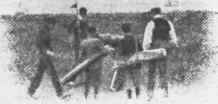The Cutting Approach Stroke
Description
This section is from the book "Hints To Golfers", by O. K. Niblick. Also available from Amazon: Hints To Golfers.
The Cutting Approach Stroke
If one sweeps the club away from the body with the backward swing so that with the forward swing it cuts diagonally across the line of flight, one can make the ball bite into the ground and fall dead without rebounding, the essence of the stroke being the very sharp left to right spin given the ball. This shot, which is used largely by all professionals, is known as the cutting approach stroke and the ability to make it, more than any other stroke, separates the professional player from the first-class amateur. In making the stroke
(1) Stand with the ball opposite the toe of the left foot so that the club can swing freely across the line of flight and give to the ball as much spin as possible.
(2) Grasp the shaft the same as when making a stiff arm shot but hold it as loosely in the left hand as one can and still hit the ball with accuracy, in order to give the ball as much spin as possible.
(3) With the backward swing, carry the club head along the ground but away from the body as far as the arms will reach, so that with the forward swing the club head will cut diagonally across the ball, the rest of the stroke being the same as when making a stiff'arm stroke.

Oh, this is hard !
(4) With the forward swing, bring the club head around slowly and across the line of flight, striking the ball squarely in the centre and if possible on the heel of the club rather than in the centre of the face.
(5) With the follow through, let the club swing well to the left of the line of flight.



a b - the sweep of the iron.
1 - the half swing.
2 - the quarter swing.
3 - the wrist swing.
Suggestions
Never make more than a half swing and use a mid-iron or a cleek rather than a lofter or a mashie so as not to get under the ball.
Remember that, because the club swings diagonally across the line of flight, the ball will not travel as far as if a stiff arm stroke had been used.
Remember that the difficulty in making the stroke is in being able to swing the club head across the line of flight without pulling the ball.
Remember to keep the heel of the iron well down so that the ball will be hit squarely and well forward so that it will not be hit too near the toe of the club. In this way one gets all the benefit of drawing the club head across the ball.
Because of the spin, if the ball runs instead of biting into the ground it will break to the right. Therefore, pitch the ball to the left of the hole.
If the ball is lying in loose sand, the stroke should never be used, as the looseness of the sand so affects the spin that the ball is as apt to fly to the right or left as along the line of flight.
Because a clean struck ball will roll true on smooth ground and because a ball played with a spin may not fall dead but may break to the right, do not use a cutting approach stroke over smooth ground if the run which the ball will have can be correctly estimated.

Continue to:


